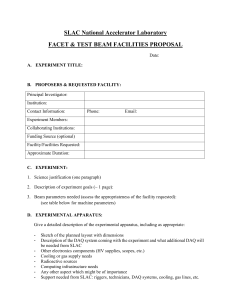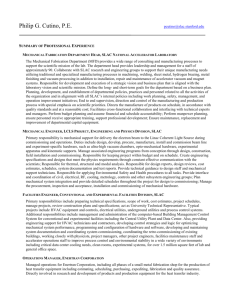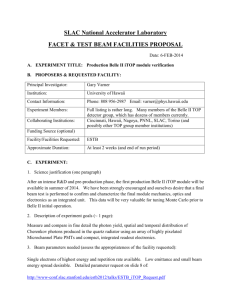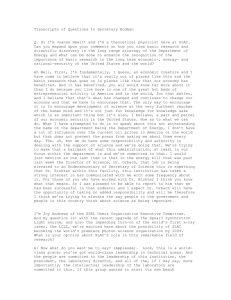06_SiDWorkshop_Colby
advertisement
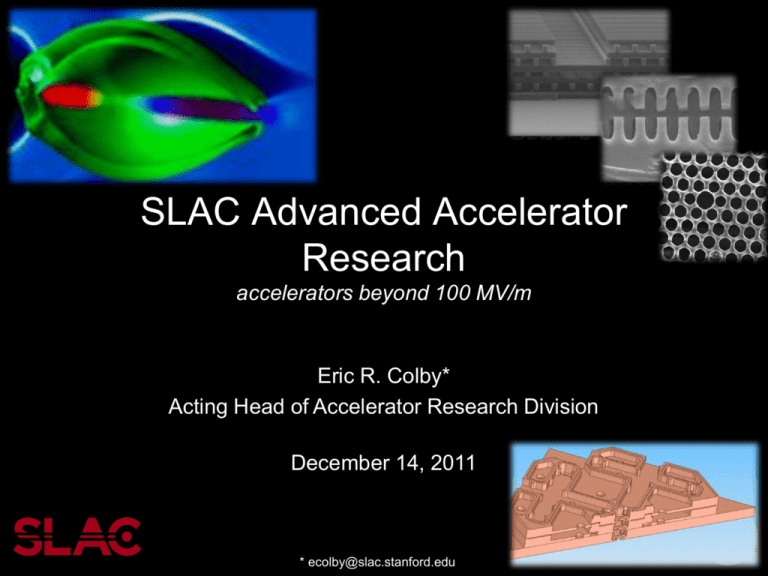
SLAC Advanced Accelerator Research accelerators beyond 100 MV/m Eric R. Colby* Acting Head of Accelerator Research Division December 14, 2011 * ecolby@slac.stanford.edu Outline • Advances in RF concepts • Novel Acceleration Concepts • Plasma Wakefield Acceleration •Recent Progress •Towards a PWFA linear collider at 1 TeV • Laser-Driven Dielectric Accelerators •Recent Progress •Towards a DLA linear collider at 10 TeV • Thoughts on the Future BreakdownProbability 1 pulsemeter RF Accelerators: Prospects for Further Progress 10 a a a 0 10 1 10 2 10 3 10 4 10 5 10 6 10 7 0 100 200 0.105, t 2.0mm, SLAC 0.143, t 2.6mm, SLAC 0.215, t 4.6mm, KEK 300 400 Peak Electric Field MV m Dual mode accelerating structure 1 1 4 500 • Surface gradients >300 MV/m have been reliably produced in single-cell cavities •Material science to identify the best materials •Investigation of roles E and H play in breakdown process •Geometry optimization • Using high gradient RF requires more efficient, lower cost power sources •Novel sources using •Photoemission sources •Magnet-free transport •Lower voltages Engineering: Gordon Bowden Solid model: Bob Reed For details see A.D. Yeremian talk Monday afternoon Sami Tantawi, SLAC Plasma Wakefield Acceleration Progress Demonstrating Key Aspects of Plasma Wakefield Acceleration • SLAC/UCLA/USC FFTB experiments 1998 - 2006 – Plasma Wakefield Acceleration of electrons over meter scales • 50GeV/m accelerating gradient • Total energy gain of 43GeV – First plasma acceleration of positrons – Systematic studies of integrated & time dependent focusing • electrons (extended propagation, emittance preservation @ 10-4m) • positrons (halo formation, emittance growth) – Refraction of electron beam at plasma boundary – Betatron radiation from strong plasma focusing • x-rays @ 1014 e-/cc (kT/m) • gammas (e+ production) @ 1017 e-/cc (MT/m) – Dielectric Wakefield Acceleration • Proof of principle studies of material breakdown threshold – 14GeV/m induced catastrophic breakdown in 1cm long, 100µm diameter fused Si tubes (we turned the dielectrics into plasmas!) • 2008 DOE Recognized the need for an ‘Advanced Plasma Acceleration Facility’ 5 Mark Hogan, SLAC FACET: Facility for Advanced aCcelerator Experimental Tests New Installation @ 2km point of SLAC linac: •Chicane for bunch compression •Final Focus for small spots at the IP •Experimental Area (25m) Experiments here FACET Beam Parameters A Unique Facility for Accelerator Science Energy 23 GeV Charge 3 nC sr 10 µm sz 20 µm Peak Current 22 kA Species e- & e+ Mark Hogan, SLAC E200: Plasma Wakefield Acceleration 5 year targeted R&D on single stage plasma accelerator physics • • • • Accelerating gradients > 10GeV/m, Focusing fields > 1 MT/m Meter scale, high density field ionized plasmas (Li, Cs, Rb) Demonstrate single stage plasma accelerator: meter scale, high gradient, preserved emittance, low energy spread First experiments (2012) will quantify head erosion with single high-current bunches Follow on experiments (2012-2013) will use notch collimator to produce independent drive & witness bunch Next phase will use pre-ionized plasmas and tailored profiles to maximize single stage performance: total energy gain, efficiency Betatron & Synchrotron radiation, instability studies Mark Hogan, SLAC • • • 7 Several paths are being investigated • Non-linear regime with electrons and positrons – Majority of activity at SLAC by SLAC/UCLA/MPI collaboration; new program taking shape at DESY • Large wake amplitude, high efficiency, ion column for extended propagation and emittance preservation • More difficult for positrons • FACET program at SLAC targeted to address many of the issues associated with applying PWFA to single stage of a PWFA based linear collider • Linear or quasi-linear regime with electrons – Active experiments at BNL using tailored electron bunch trains to resonantly drive plasma wave • Potential for larger amplitude and higher transformer ratio • Reduced benefits of ion column: extended propagation, emittance preservation • Proton Driven Plasmas (PD-PWFA) – Collaboration led by MPI/CERN delivering full proposal to begin experimental program at CERN staring in 2015. FNAL beginning to evaluate concepts using portions of the Tevatron. • Potential to reach ~TeV e- energy in single long (~400m) plasma stage • Takes advantage of large stored energy in High Energy proton bunches • Reach the energy but difficult to get the beam power needed for luminosity Mark Hogan, SLAC Proton Wake Expts Mark Hogan, SLAC Key features of a PWFA-LC • Electron drive beam for both electrons and positrons • High current low gradient efficient 25GeV drive linac – Similar to linac of CERN CTF3, demonstrated performance • Multiple plasma cells – 20 cells, meter long, 25GeV/cell, 35% energy transfer efficiency • Main / drive bunches – 2.9E10 / 1E10 PWFA-LC concept will continue to evolve with further study and simulation – Bunch charge; Non-gaussian bunch profiles; Flat vs round beams; SC vs NC pulse format; ... • FACET facility will investigate and iterate these ideas through experiments Mark Hogan, SLAC IP Parameter Optimization • Conventional <1TeV LC is typically in low quantum beamstrahlung regime (when Y=2/3 ωcћ/E <1) – The luminosity then scales as L ~ δB1/2 Pbeam / εny1/2 (where δB is beamstrahlung induced energy spread) • High beamstrahlung regime is typical for CLIC at 3TeV • PWFA-LC at 1TeV is in high beamstrahlung regime • Scaling and advantage of high beamstrahlung regime – L~δB3/2 Pbeam /[σz βy εny]1/2 and δB~σz1/2 – short bunches allow maximizing the luminosity and minimizing the relative energy loss due to beamstrahlung • Optimization of PWFA-IP parameters performed with high quantum beamstrahlung regime formulae and verified with beam-beam simulations Mark Hogan, SLAC Primary Issues for any Plasma-based LC • Need to understand acceleration of electrons & positrons • Luminosity drives many issues: – High beam power (20 MW) efficient ac-to-beam conversion – Well defined cms energy small energy spread – Small IP spot sizes small energy spread and small Δε • These translate into requirements on the plasma acceleration and the experimental programs – – – – High beam loading of e+ and e- (for efficiency) Acceleration with small energy spread Preservation of small transverse emittances – maybe flat beams Bunch repetition rates of 10’s of kHz • Multiple stages allow better beam control and use of drive-beam – FACET aims to demonstrate single stage before full system test Mark Hogan, SLAC A Self-consistent Design of a 1 TeV e-e+ Linear Collider Based on PWFA • TeV collider design has multiple acceleration stages, each adding ~25 GeV/stage • FACET PWFA program aims to demonstrate a single stage with needed Q, E E , efficiency, emittance preservation • Results will inform designs for future applications (HEP, Photon Science) see A. Seryi et al., PAC09 Proceedings Mark Hogan, SLAC PWFA-LC Efficiency & Power Estimate 170MW 43MW Other Systems 127MW Modulators 83% Klystrons 65% Distribution 93% .83x.65x.93=50% 63.5MW 90% • Current design uses Gaussian beams, 35% efficiency • Tailored current profiles have achieved 90% efficiency in simulation – Better overall efficiency – Improves heat management problem in plasma cell Plasma Wave 35% Drive Beam 57MW Mark Hogan, SLAC Main Beam 20MW 1 TeV PWFA LC Parameters Ecm = 1 TeV, L = 1034 cm2s-1 Laser-Driven Dielectric Accelerators Motivation P/l 2 Dielectric Damage Threshold 1053nm 2 J/cm2 @ 1 ps >2 GV/m 30cm 3m 3cm 300nm 3mm Source Wavelength *28.5 GeV, 1e10 ppp, 1m x 1m x 600m (20m for SPPS) beam 300m 30m l B. C. Stuart, et al, Phys. Rev. Lett., 74, p.2248ff, (1995). **350 MeV, 1e10 ppp, 1m x 1m x 1 mm beam Fused silica, THz range, ~psec exposure Cockcroft Inst, U.K. U. Lancaster, U.K. LLNL LBNL Stanford MIT Q-Peak Inc. Purdue Minotech Engineering SLAC UCLA Radiabeam Technologies Incom Inc. U. Colorado, Technion, Israel NTHU, Taiwan Manhattanville College Tech-X Corp. U. Maryland DOE • 51 Participants = 46 US+5 International • 10 Universities • 4 National Labs / Institutes • 5 Companies • Accelerator • Laser Science & Technology • Photonics • Novel Materials • Simulations There is a wealth of concepts being developed… cylindrical lens vacuum channel cylindrical lens laser beam top view z electron beam y x l/2 l Dielectric Laser Acceleration Primary challenge for laser acceleration: mode is transverse electromagnetic—must develop longitudinal electric fields to accelerate Structure Candidates for High-Gradient Accelerators Projected maximum gradients based on measured material damage threshold data Photonic Crystal Fiber Silica, l=1890 nm, Ez=400 MV/m Transmission Grating Structure Photonic Crystal “Woodpile” Silicon, l=2200nm, Silica, l=800nm, Ez=400 MV/m Waveguiding Structure Waveguiding Structure Ez=830 MV/m Phase Mask Structure Much tighter (and all solid-state) coupling means • MW-class not PW-class lasers are needed (Microjoule-class pulse energies, not 10-100J class laser) • Shot-to-shot reproducibility is better Laser Coupling to Structures Transverse Coupling to Woodpile Structure ~90% power coupling [courtesy B. Cowan, Z. Wu] Coupling from transverse waveguide to accelerating mode of the woodpile structure. >90% coupling from silicon waveguide input couplers to accelerating channel; fabrication R&D of test couplers underway [Z. Wu, D. Xu] Joel England, SLAC Benchtop Testing of Structures Phase Stability of PBG Structures Breakdown Strength of Dielectric Materials 2 J/cm2 ~ Epk=5 GV/m Al2O3 1 d N 9 ppm /˚C dT neff .L.T / l [633 nm HC fiber] 3˚ phase / ˚C for L = 1000l S HfO2 Si3N4 SiO2 S i R. Laouar ZrO2/Y2O3 K. Soong Joel England, SLAC DLA: The Laser Acceleration Facility at the NLCTA (Commissioned March 2007) E S B Counting Room (b. 225) Ti:Sapphire Laser System Cl. 10,000 Clean Room E-163 RF PhotoInjector Optical Microbuncher Gun Spectrometer Next Linear ColliderNext Test Accelerator Linear Collider Test Accelerator The E163 program has advanced rapidly due to three factors: Experimental Hall • A decade of experience conducting this type of experiment at Stanford • Extensive NLCTA infrastructure required modest extension to make a functioning facility • Experienced help from the Test Facilities staff at every step E-Beam Microbunching Net laser acceleration of 1.2 keV demonstrated for 400 attosec microbunches using inverse transition radiation (ITR) at a metal foil. C.M.S. Sears, et al. “Production and characterization of attosecond electron bunch trains,” PRST-AB 11, 061301 (2008)]. C.M.S. Sears, et al. “Phase stable net acceleration of electrons from a two-stage optical accelerator.” PRST-AB 11, 101301 (2008). Joel England, SLAC First Microaccelerator Demonstration: January 2012 •Will demonstrate gradient LASER E. Peralta 1 mm alignment channels 8 x1mm2 gratings 20x50µm spot Edgar Peralta, Stanford Multi-Stage Layout Concept 5 modules per wafer 1 laser per module (200W per laser) Loop period=beam repetition rate Phase control 40 structures per module 1 module = 10 cm long 1 stage = 750 µm long ... x 16,000/TeV 6'' wafer Main Linac (one half) 5 TeV 12.5 km 400,000 lasers Thulium fiber laser l2 µm Joel England, SLAC E-Beam Pulse Format 30 attosec N~3e4 2 mm 159 micropulses per train, 1pC/train Train length= 1ps300 microns T_sep=200 nsec 10 TeV DLA LC Parameters Parameter CM Energy Loaded Gradient Bunch Charge Bunches per train Train Rep Rate Microbunch Length Design Wavelength Normalized Emittance IP Spot Size Units GeV MeV/m e # MHz micron micron micron nm DLA 10000 400 3.8E+04 159 5.00 2.6E-03 1.89 1.0E-04 0.06 SCRF 10000 30 3.0E+10 2820 5e-06 320.29 230609.58 10.00 158.00 Disruption Parameter # 1.28E+02 2.06E-01 Beamstrahlung Parameter Beam Power Active Linac Length # MW km 1002.6 24.2 12.5 5.6 339 166.7 Beam Coupling Efficiency # 0.3 0.3 MW 85.7 1016.5 # 0.50 0.60 Total Wall Plug Power MW 171.3 1694.1 Beamstrahlung E-loss % 5.7 91.0 Enhanced Luminosity /cm^2/s 4.09E+36 1.23E+36 Total Laser/RF Power Wall-plug to Light Efficiency Joel England, SLAC Thoughts for the Future • Electric fields well beyond 100 MV/m have been sustained reliably in short rf-driven metal accelerators – This remains the nearest-term high gradient technology for a greenfield TeV-class machine • Fields beyond 50 GV/m have been sustained in dense plasma wakefield accelerators – Extraordinary gradient has already been demonstrated with respectable shot-to-shot stability; demonstrations of high quality and high efficiency acceleration are imminent • Fields well beyond 1 GV/m have been sustained in dielectric accelerator structures in both quasi-CW and broadband – The very small bunch charge, high repetition rate operation of a DLA offers the only path to multi-TeV accelerators with acceptable beamstrahlung Power and Efficiency 200W avg power 2µm wavelength Per Module: Accelerator absorption loss: 5 mW Cherenkov absorption: 10 mW Waveguide absorption loss: 577 mW (assumes SiO2 substrate, 1e-3 dB/m) assumes near 100% efficiency of waveguide couplers, splitters 5% coupling loss e-beam beam dump 30% coupling to e-beam (61%) absorption at vacuum box wall Joel England, SLAC 200W in a fiber? How about 20kW? http://www.ipgphotonics.com/documents/documents/HP_Broshure.pdf PWFA-LC Efficiency & Power Estimate Mark Hogan, SLAC Long-Term Timeline NLCTA-like test facility for DLA technology Gain in performance, Progress towards realization, New scientific knowledge Operational Improvements Major Project Engineering Begins compact multi stage device Engineering Tests Underway RESEARCH DEVELOPMENT Physics Largely Understood Present Concept Concept implemented as a working machine Proof-ofCommunity Principle Develops Experiments Critical Mass of Experimental Effort Achieved (people+facilities) 5 years 10 years 20 years Adapted from AARD SPC report 2011, E. Colby Joel England, SLAC Other Subsystems of PWFA-LC • Design of injectors, damping rings, bunch compressors, are similar to designs considered for LC and the expertise can be reused – Extensive tests of damping ring concepts at KEK ATF Prototype Damping Ring and the CESR-TA Test Facility • Final focus system similar to conventional LC designs – Tested at Final Focus Test Beam and soon at the ATF2 at KEK • Present design of Final focus and collimation has full energy acceptance of slightly greater than 2% – May need to deal with a factor of two larger energy spread for PWFA-LC – Further optimization of Final Focus and Collimation will need to be performed Mark Hogan, SLAC Plasma cells & flexibility of the concept • Plasma cell is the heart of the PWFA-LC concept • FACET will be able to produce a wide variety of beams to study the beam loading and acceleration with different plasmas – The initial tests will be done with lithium plasma • In the PWFA-LC, the plasma in each cell needs to be renewed between bunches and stability of the plasma parameters is crucial – A high speed hydrogen jet is a possible candidate • PWFA-LC concept is flexible wrt beam pulse format: – Bunch spacing presently assumed to be typical of NC drive linac: ~4ns • It can be doubled with the addition of RF separators and delay beamlines that can run along the drive linac • Increasing the bunch spacing by orders of magnitude could be done with a stretching ring, where the entire drive train would be stored and then bunches would be extracted oneby-one with fast rise kickers – Alternately could use a SC drive linac for very long spacing Mark Hogan, SLAC Wakefield Simulations Field monitor Optimized PBG Accelerator Commercial Fiber Used in Experiment blue box = bandgap blue box = bandgap beam [courtesy Cho Ng] ACE3P simulation of HC-800-1 fiber with axial current excitation. Time domain. current pulse RMS duration = 0.2 /c [scaled to actual design wavelength] one mode excited many modes excited Joel England, SLAC Single-bunch BBU-driven emittance growth is manageable Misalignments N=234 •Xq=Xa=50 nm •X’o=0 rad, Xo=0 nm •Grouping=10 Beam •go=1000 •s=5/360l •Q=varies Accelerators •Ls=1000l •R=5l •er=2.31 •G=500 MV/m Quad Lattice •Leff=2.5 mm •y=90o •Lq=5 m •Kq=600 T/m Fit: de=3.0x10-10 q1.28
